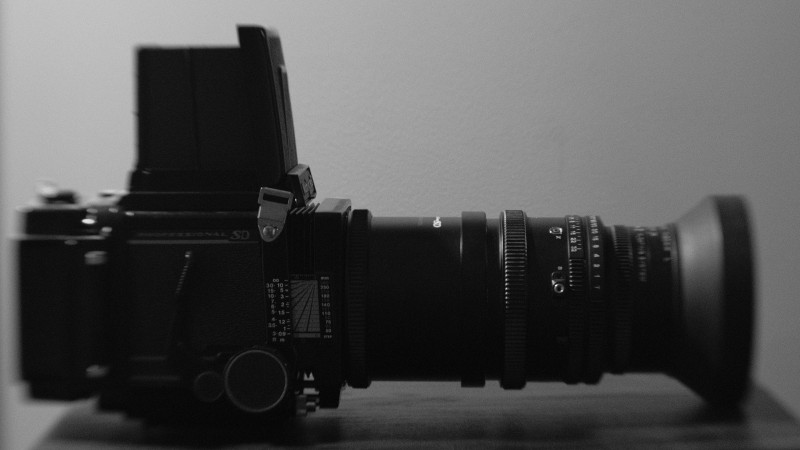
Below is a table that shows the light loss for every Mamiya RB67 prime lens, when combined with each extension tube individually, and with both extension tubes together. This table also applies to the Mamiya RZ67.
| Lens Focal Length | No. 1 (45mm) | No. 2 (82mm) | No. 1 + No. 2 (127mm) |
|---|---|---|---|
| 37mm | 2.2 stops | 3.2 stops | 4.4 stops |
| 50mm | 1.9 stops | 2.6 stops | 3.5 stops |
| 65mm | 1.7 stops | 2.3 stops | 3.0 stops |
| 75mm | 1.6 stops | 2.1 stops | 2.7 stops |
| 90mm | 1.5 stops | 1.9 stops | 2.4 stops |
| 127mm | 1.4 stops | 1.6 stops | 2.0 stops |
| 140mm | 1.3 stops | 1.6 stops | 1.9 stops |
| 150mm | 1.3 stops | 1.5 stops | 1.8 stops |
| 180mm | 1.2 stops | 1.5 stops | 1.7 stops |
| 210mm | 1.2 stops | 1.4 stops | 1.6 stops |
| 250mm | 1.2 stops | 1.3 stops | 1.5 stops |
| 350mm | 1.1 stops | 1.2 stops | 1.4 stops |
| 360mm | 1.1 stops | 1.2 stops | 1.4 stops |
| 500mm | 1.1 stops | 1.2 stops | 1.3 stops |
Theory and Practice
The Mamiya RB67 camera system has two different sizes of macro extension tubes available.
- The “No. 1” extension tube is 45mm long.
- The “No. 2” extension tube is 82mm long.
It is also possible to connect the “No. 1” and “No. 2” tubes together, for a total of 127mm of lens extension.
Whenever you put a macro extension tube in between your lens and your camera, you will necessarily lose some light. Your f-stop is defined as the focal length of your lens divided by the width of the aperture. When you insert a lens extension tube, you are making the focal length of your lens longer, but the aperture stays the same size. Therefore, your effective f-stop becomes correspondingly smaller.
For example, imagine that you are using the 127mm lens, and it is set to an aperture of f/4. This means that the aperture is 31.75mm, because 127 divided by 4 is 31.75. Let’s say that you add both macro extension tubes, which adds another 127mm to your focal length. Now, it's as if you are using a 254mm lens, but your aperture is still 31.75mm. 254 divided by 31.75 is 8. Your new aperture after adding these extension tubes is effectively f/8, on a 254mm lens. An aperture of f/8 as compared to f/4 means that you have lost two stops of light in this scenario.
You can calculate macro extension tube light loss yourself for any camera, any lens, and any length of extension tube. The formula is:
( lens_focal_length + extension_tube_length ) / lens_focal_length
So, for example, if you have a 127mm lens, and a 45mm extension tube:
( 127 + 45 ) / 127
172 / 127
1.3543307086614174
Then, after rounding to the nearest 1/10th of a stop, we get 1.4 stops of light loss. Then we can round some more because the Mamiya RB67 only lets you adjust the aperture in half stop increments. Assuming you are shooting negative film (which prefers overexposure to underexposure), your best bet in this case would be to overexpose by about 1.5 stops as compared to your meter reading to get a correct exposure.
If doing math every time you change extension tubes sounds like a pain, you can also meter normally, and just plug the amount of macro extension tube light loss from the table above into the Photographic Exposure Calculator on this website.